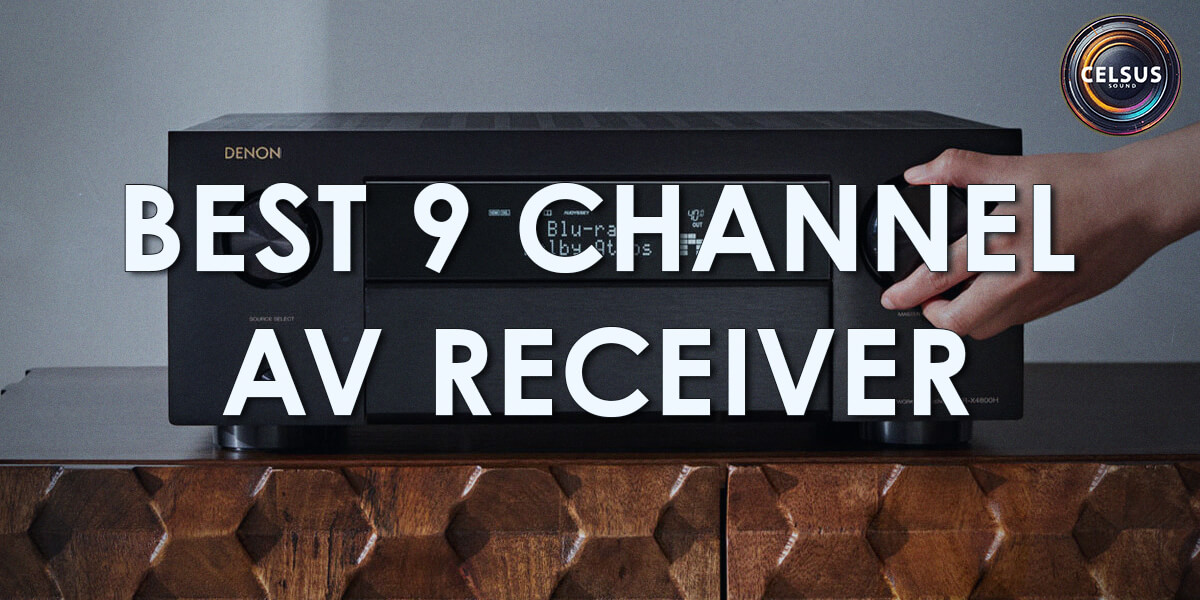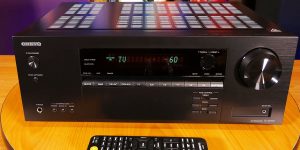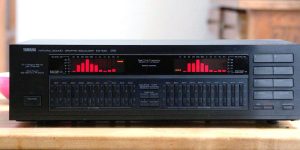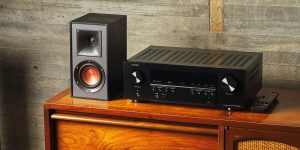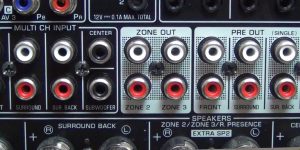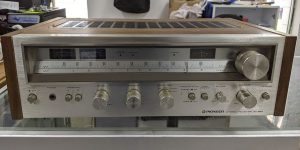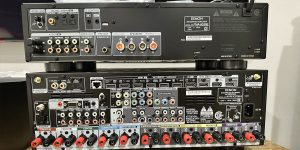When it comes to building a home theater system, having a high-quality receiver is essential for achieving the coolest sound quality and immersive experience. For those looking for a receiver that can guarantee versatility, surround sound, and sufficient power, 9-channel models are an optimal option. Due to their special features, these devices offer a range of features and benefits for audiophiles and home theater enthusiasts alike. In this article, I will take a closer look at some of the best 9-channel receivers on the market and explore their features, pros, and cons.
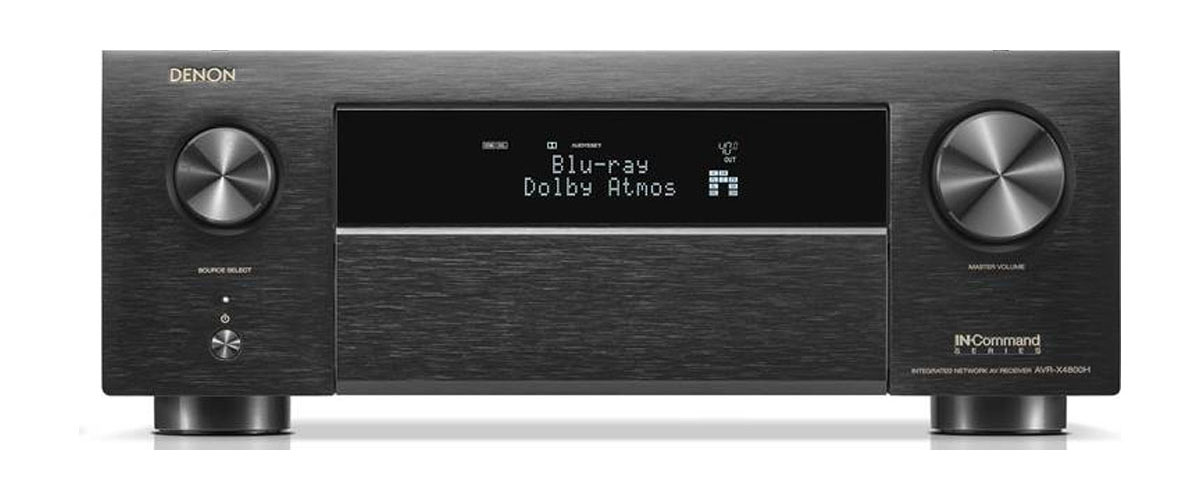
9.2 AV receivers comparison table
| Name | Channels | Power output | HDMI in/out | Bluetooth/Wi-Fi | Review |
|---|---|---|---|---|---|
| Denon AVR-X4800H best overall | 9.2 | 125W/8 Ohm, 165W/6 Ohm | 7/2 | yes/yes | Review |
| Marantz Cinema 50 also a great | 9.4 | 110W/8 Ohm, 150W/6 Ohm | 6/2 | yes/yes | Review |
| Onkyo TX-RZ50 budget | 9.2 | 120W/8 Ohm | 7/2 | yes/yes | Review |
What is a 9.2 home theater system?
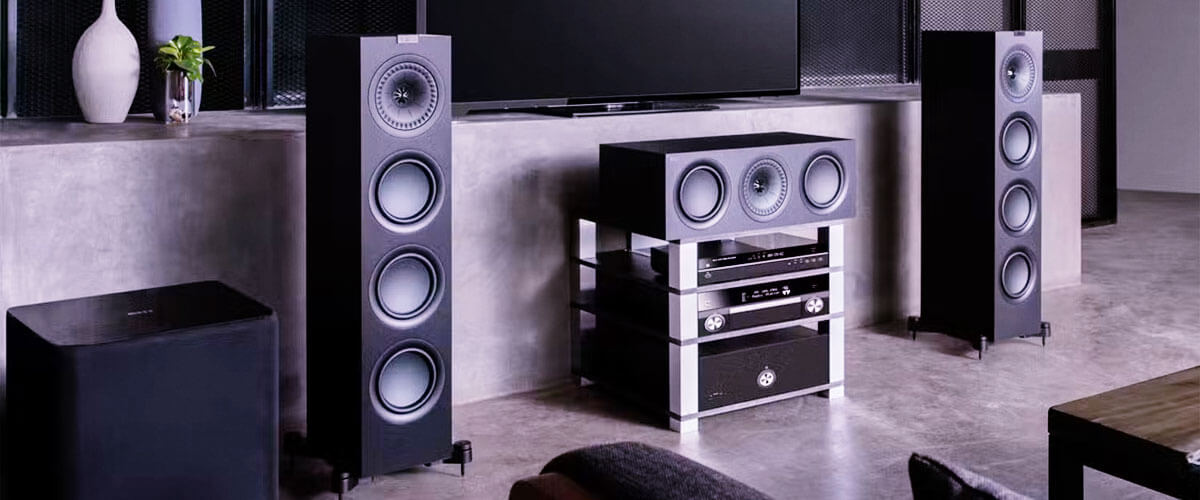
This configuration home theater system is made up of two subwoofers, two surround speakers, two rear speakers, two ceiling or upward-firing speakers, and a center channel speaker. It provides an immersive surround sound experience and allows the receiver to handle the latest surround sound formats: Dolby Atmos, DTS:X, IMAX Enhanced, and Auro-3D.
A 9.2 channel system suits well for movies, gaming, and listening to music. While the latter is not why such systems are valued, I still run my tests in music as this allowed me to cover every AV receiver option from all possible sides. So, this review includes thorough details on each receiver’s many features and capabilities and aims to determine which is the better option for you concerning budget, room size, and other aspects.
How to choose a 9-channel receiver
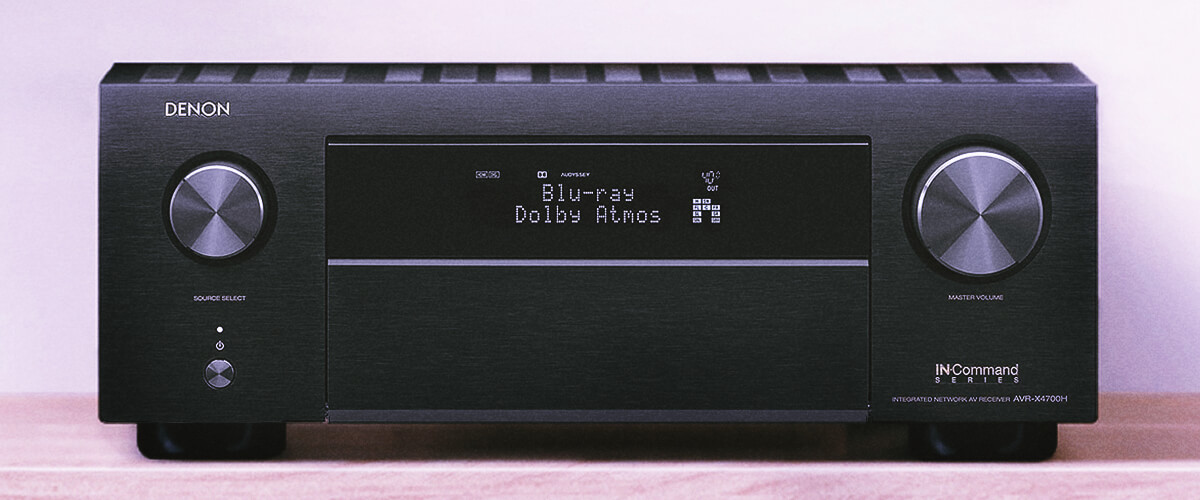
Before you choose a specific device model, I want to discuss the most important factors to consider when buying a 9-channel AV receiver.
How much power do you need
Power is the first indicator you are likely to pay attention to. However, its value is often overestimated (especially by beginners). It is not necessary to look for a receiver with very high values of this indicator. For most users, the value of 100W/channel will be more than enough. Such power will be optimal for rooms with an area of about 350-450 square feet. In 9-channel models, the power is usually even more than this value (about 110-150 W/channel). So, if you plan to place your multimedia system even in a spacious living room (400-500 square feet), this power will be more than enough for you.
Also, pay attention to THD values. The smaller the figure, the more pure (without “wheezes and crackles”) sound you will get at maximum volume. So, in my opinion, a receiver with 125W/channel power and low THD will sound much cleaner than a more powerful device with a higher THD value.
I would also advise you to look for a model with rear panel output jacks for the preamplifier. This is your investment for the future since you can add a power amplifier later on (if, for some reason, the standard power of the unit becomes insufficient for you).
What connections do you need
I recommend following the simple but very important rule: “The more, the better”. Suppose you already have a certain number of devices that you want to connect to the receiver. But tomorrow you will buy more equipment and think about how to connect it now because there are not enough ports. To avoid such situations, remember and use my rule. Now, let’s take a closer look at the types of ports, connections, and what you should be guided by.
HDMI ports
This is the most important port type, as it allows you to work with modern devices. Look for models with at least 5 HDMI inputs so that you can connect cable TV, Blu-ray player, and game console and leave 2 more inputs for future system expansion.
Also, pay attention to the HDMI version. I do not recommend buying models with HDMI versions lower than 2.1. But if you do opt for an older receiver (because of sound quality or price), make sure that it is at least 4K compatible to maximize the streaming and gaming capabilities of this format on modern TVs. Simply put, it should be equipped with HDMI 2.0a and HDCP 2.2 certification.
Other connections
If you have a lot of outdated equipment (CD/DVD player, VCR, cassette recorder, etc.) or music equipment (e.g., vinyl player) and want to integrate it into your AV system, make sure that your receiver has the appropriate ports. Pay attention to the phono input (for connecting a vinyl player), RCA jacks, headphone input, optical digital out, USB, and a few others.
Wireless multi-room music
We have long been accustomed to wireless technology, so a receiver (especially a 9-channel receiver) simply has to have such capabilities nowadays. Many modern models come with built-in wireless functions (e.g., HEOS from Denon, MusicCast from Yamaha, etc.) and are controlled by a special application on a smartphone, tablet, or computer. I am sure you will like the idea of organizing autonomous wireless multimedia zones in your house or apartment.
Dolby Atmos and DTS:X
You are probably most interested in surround sound. After all, we all want to hear the thundering scream of the Hulk, the real chime of swords in the battle between Achilles and Hector, to feel the incredible sound magnetism of the sandy planet Dune. Dolby Atmos and DTS:X technologies will help us with that. So, if you buy a receiver for watching cinematic masterpieces (and I think it is), first of all, check if it supports these formats.
9-channel models are perfect for getting modern Dolby Atmos and DTS:X surround sound (it is less demanding on equipment). With this configuration, you will really get a real 3D sound, where each sound effect will hover at the right point in the space of your room.
I would like to add that the downside of a modern 3D audio system is that you need to mount the speakers for the upper channels on the ceiling or the walls (on mounting brackets). If this option is not available to you, don’t despair. With DTS Virtual:X and Dolby Atmos Height Virtualization (and many modern receivers support them), you’ll get equally immersive surround sound without the need for overhead speakers.
Best 9.2 receiver reviews
| Article navigation |
|---|
| Denon AVR-X4800H – best overall |
| Marantz Cinema 50 – also a great |
| Onkyo TX-RZ50 – budget |
| Yamaha RX-A6A |
| Pioneer Elite VSX-LX505 |
| FAQ |
Denon AVR-X4800H – best overall

The AVR-X4800H belongs to the Denon AVR-X Series of AV receivers, famous for user-friendliness, a rich set of features, and quality audio. This 9.2 channel receiver model was released in 2020. The reason why I wanted to test this unit so much is that, in certain features and aspects, it is equal to the older X8500H and, therefore, may have very serious potential.
Traditional Denon design is no surprise to anyone. Nevertheless, I pay greater attention to the design quality when it comes to more expensive models, such as the X4800H. For example, the control panel is completely hidden under a hinged metal cover. I find this aesthetically pleasing and convenient, but it also protects the buttons from dust. A large, informative screen that shows all your manipulations. The controls are smooth and precise. However, the RCA connectors here are ordinary, although Denon produces newer models of this rank already with gold-plated ones. In addition, the remote control looks outdated and has no backlight.
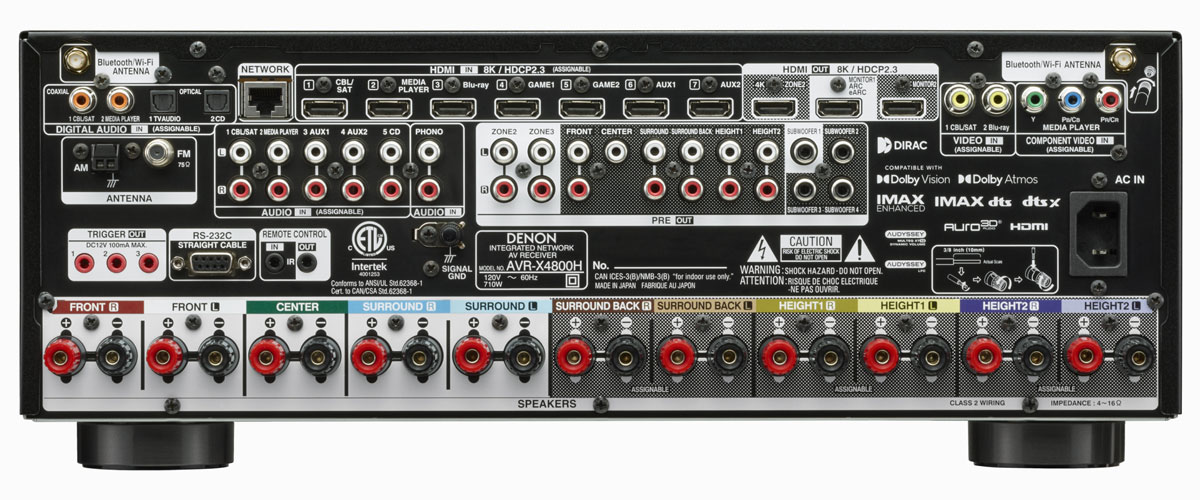
Let me start by saying that the unit has a stunning 11.4 channel multiplex pre-out and digital/analog multiroom support. A little spoiler from me – during my tests, the X4800H offered immersive and dynamic sound, creating a real home theater experience, which is not so surprising as it can pump up to 125W per channel.
On the HDMI side, the unit features 7 inputs and 3 outputs both support HDCP 2.3. The receiver can play native video at 8K/60Hz and 4K/120Hz pass-through. The former serves better for movies, and the latter is ideal for gaming. It also offers the HDR10+ family of technologies, Dolby Vision and HLG.
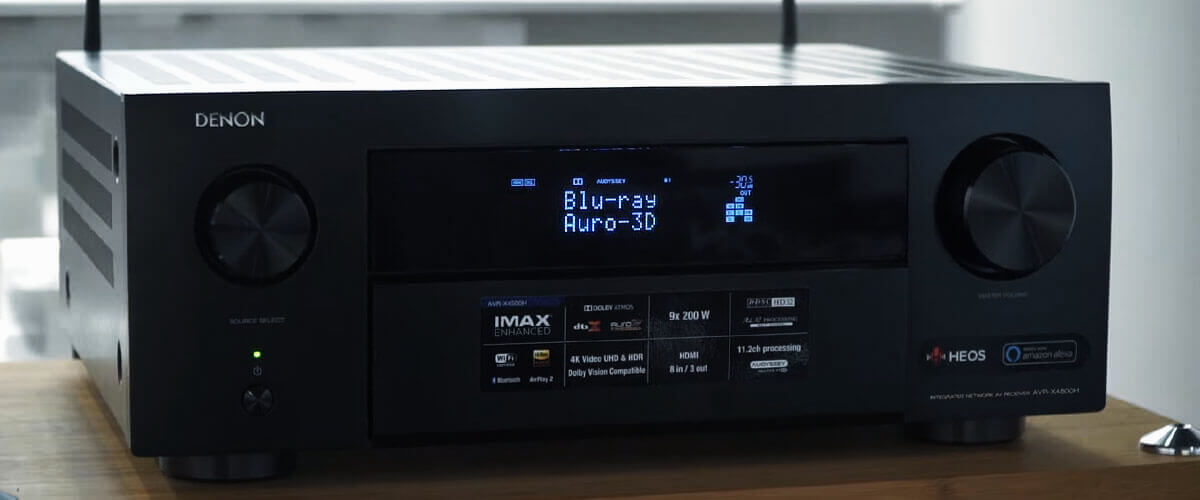
I couldn’t wait to test its surround sound capabilities. After all, it supports a rich set of the latest immersive sound technologies, including Dolby Atmos, DTS:X, and Auro-3D. So, I decided to put it to the test and gathered a whole collection of different content of different genres and release years. So, my movie and TV series list included The Last of Us, The Dark Knight, The Grand Budapest Hotel, and other blockbusters. During the whole test, the AVR-X4800H offered an immersive and dynamic sound stage putting me right inside the movie’s atmosphere. Every detail during action moments was distinctive and readable. At the same time, the unit provided a powerful sound with no distortions and maintained readable heights and lows.
Before the test, I expected that the AVR-X4800H would share the same destiny as many of its AV receiver brothers – it would deliver a juicy and rich sound in music. However, the unit managed to impress me pleasantly with its mid-range frequencies and detailed sound. I also enjoyed how it handled every music genre I gave it: heavy metal songs, rock ballads, modern pop songs—all sound distinctive, rich, and pleasant.
Overall, the AVR-X4800H is the best 9-channel AV receiver because it’s a high-performance audio/video receiver that delivers amazing sound quality for both movies and music. But since every model in my selection is good in sound in one way or another, the advantages to the selection leader are a bit different. First of all, discounted for today, it has the greatest value for money in my ranking. You can add an external amplifier, add 4 subs, and get a stunning 11-channel system by spreading it across multiple zones of operation. All HDMI ports on this AVR are version 2.1, so you can enjoy 8K video without lags or outright flaws.
Of the minuses, I would mention the outdated design and remote control. But the design itself is solid and will last you for years. Combined with the recognizable warm and bright sound, the Denon AVR-X4800H deservedly takes first place in this league.
Key specs
- Channels: 9.2.
- Power output: 125W/8 Ohm, 165W/6 Ohm.
- HDMI inputs/outputs: 7/2.
- Video functions: 8K/60Hz, 4K/60Hz, 4K/120Hz, HDMI upscaling up to 8K.
- Bluetooth/Wi-Fi: yes/yes.
- Streaming services: AirPlay 2, Spotify, TuneIn, Deezer, Tidal, Netflix, Amazon Prime.
- Supports: HDMI ARC, HDMI eARC, HDMI CEC, HDCP2.3, HDR10+, Dolby Vision.
- Surround sound: DTS HD Master, DTS:X, DTS Neural:X, Dolby Atmos, Dolby TrueHD, Dolby Height Virtualization, Dolby Surround, Auro 3D, IMAX Enhanced.
Pros
- Creates an immersive and dynamic sound stage.
- A rich set of wireless and wired connection options.
- The unit offers two multiroom outputs.
Cons
- The remote looks outdated and has no light.
Marantz Cinema 50 – also great
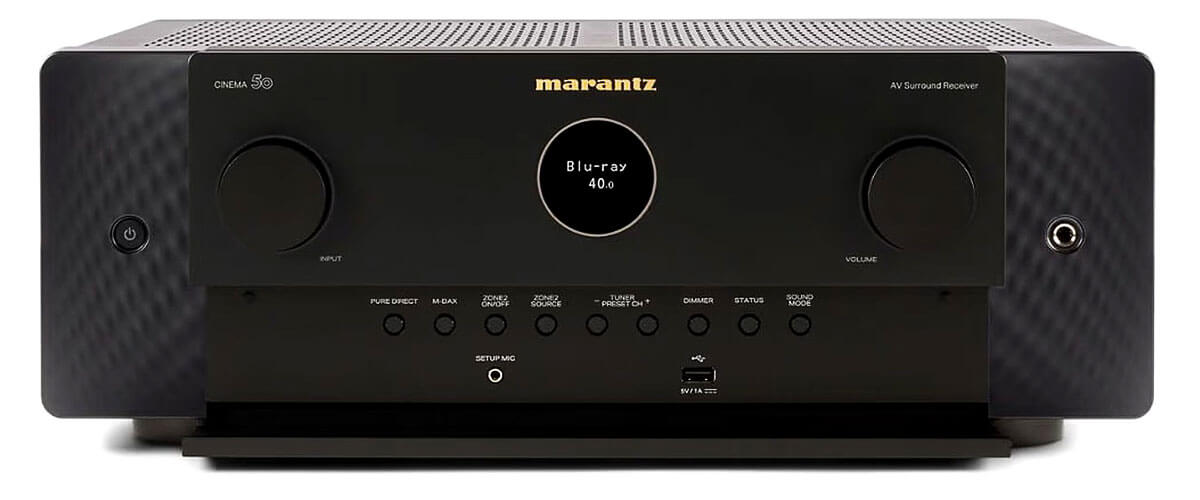
The Marantz Cinema 50 represents the second model offering in the recently launched Cinema AVR lineup. Marantz’s Cinema 40 is a more advanced unit with additional power and input options, including support for legacy video. In turn, Cinema 60 and 70 are Marantz’s budget-friendly alternatives in the same line. So, Cinema 50 offers a stunning balance between price and quality with only a few concessions compared to the older model. Yet, is it enough to call the Cinema 50 the best 9.2 receiver instead of the AVR-X4800H?
In terms of design, this model boasts an elegant and modern look that exudes style and sophistication. Its clean lines and minimalist aesthetic rounded control surfaces make it look awesome and refreshing. The front panel features a rounded display. While it’s still pretty easy to read, I would still enjoy it more if it was bigger. The main merits of the design are inside, and that’s why Marantz models are often more expensive than competitors, offering identical or even lesser features. But these machines are timeless. Over the years, the sound has not lost its power and richness. And that’s what you pay more for.
The Marantz Cinema 50 AVR has a power output of 110W at 8 ohms, 20 Hz—20 kHz, and a 0.08% 2ch Drive. The system can also handle 11 channels with an external amplifier. And you can also connect 4 independent subs. So basically, there is a parallel with the Denon AVR-X4800H, apart from the lower power.
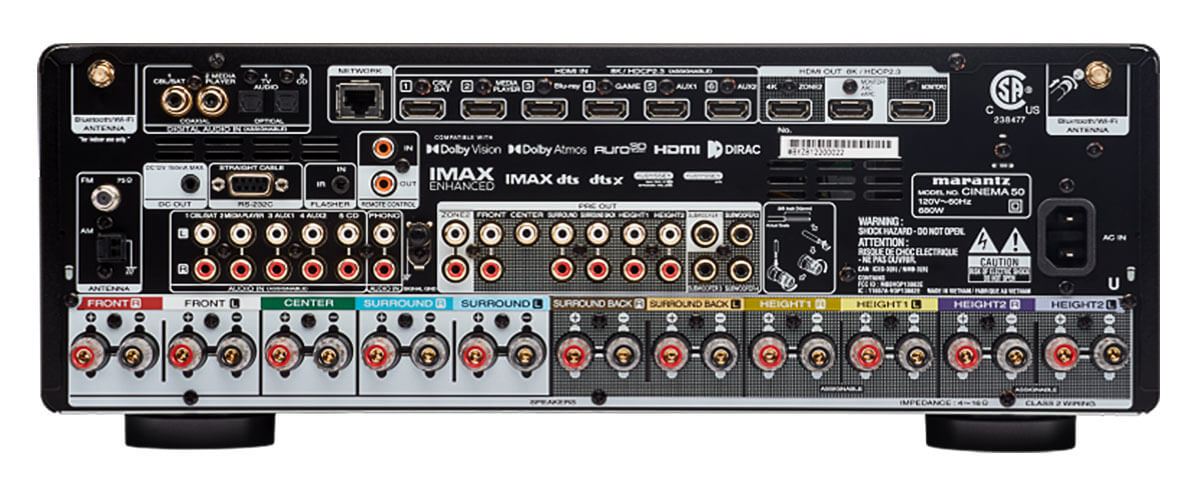
The unit has 6 HDMI 2.1 inputs, 3 outputs, and a single front USB-A, which, from my experience, adds a lot to convenience. All HDMI ports support 8K and HDCP 2.3. One HDMI output is for the primary monitor, while the other is for Zone 2. The Cinema 50 AVR can upscale 1080P/4K to 8K 60hz but does not offer analog to HDMI video conversion.
Although the device’s musical performance falls short of the supposed audiophile level, it provides some excellent lower frequencies while keeping clear heights. I frequently listen to music in MP3 format with traditional compressed audio. In turn, Cinema 50 pleasantly impressed me by enhancing the sound quality of songs recorded in compressed audio codecs. It’s about Marantz MDAX2 technology, designed precisely for this purpose, and is a brand trademark.
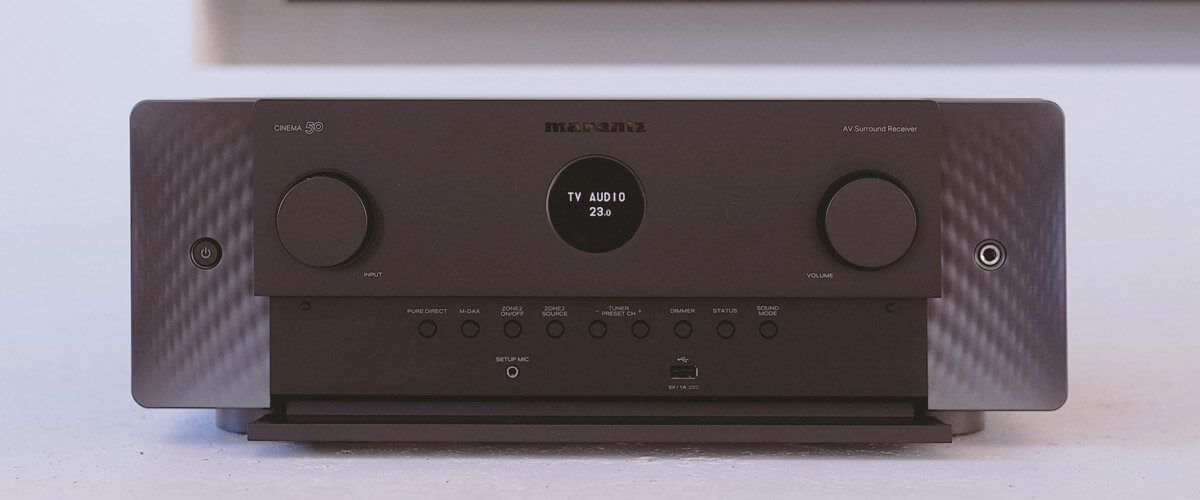
I used the same list of movies to test the Marantz Cinema 50 receiver, and I have to say that it has exceeded my expectations in terms of sound quality while watching movies. The dynamic sound stage and precise imaging truly took me into the world of movies. Compared to AVR-X4800H, which surpasses it a bit in music playback, the Marantz Cinema 50’s specialized focus on movie soundtracks really shines through, allowing me to hear every detail and nuance in the audio.
The Marantz Cinema 50 offers essentially the same features as the AVR-X4800H. The system can be expanded to 11 channels, there are pre-outputs for 4 subs, support for 8K video, the latest generation of surround sound formats, wireless features, and multi-room. It is the complete packet that the 2022 receiver has to offer in a unique package from Marantz. This all makes it one of the best 9-channel receivers currently available on the market. But there are nuances.
The Cinema 50 costs a few hundred bucks more. It has less power (110 watts vs. 125 watts) and fewer HDMI inputs (6 vs. 7). It also has very few options for connecting aging appliances (if that’s important to you). Finally, despite modern technologies (MDAX2) it feels a little more relaxed with music than Denon AVR-X4800H, having a greater orientation on movies. But even its name says so.
Key specs
- Channels: 9.4.
- Power output: 110W/8 Ohm, 150W/6 Ohm.
- HDMI inputs/outputs: 6/2.
- Video functions: 8K/60Hz, 4K/60Hz, 4K/120Hz, HDMI upscaling up to 8K.
- Bluetooth/Wi-Fi: yes/yes.
- Streaming services: AirPlay 2, Spotify, TuneIn, Deezer, Tidal, Netflix, Amazon Prime.
- Supports: HDMI ARC, HDMI eARC, HDMI CEC, HDCP2.3, HDR10+, Dolby Vision.
- Surround sound: DTS HD Master, DTS:X, DTS Neural:X, DTS Virtual:X, Dolby Atmos, Dolby TrueHD, Dolby Height Virtualization, Dolby Surround, MAX Enhanced, Auro-3D, 360 Reality Audio, MPEG H.
Pros
- The design is elegant and modern.
- Offers pure, powerful, and warm sound.
- Focused on movies, works great with 4K and 8K content.
Cons
- Has a limited number of legacy connectors. I couldn’t connect my old cassette player to it.
- The front panel display is relatively small.
Onkyo TX-RZ50 – best budget
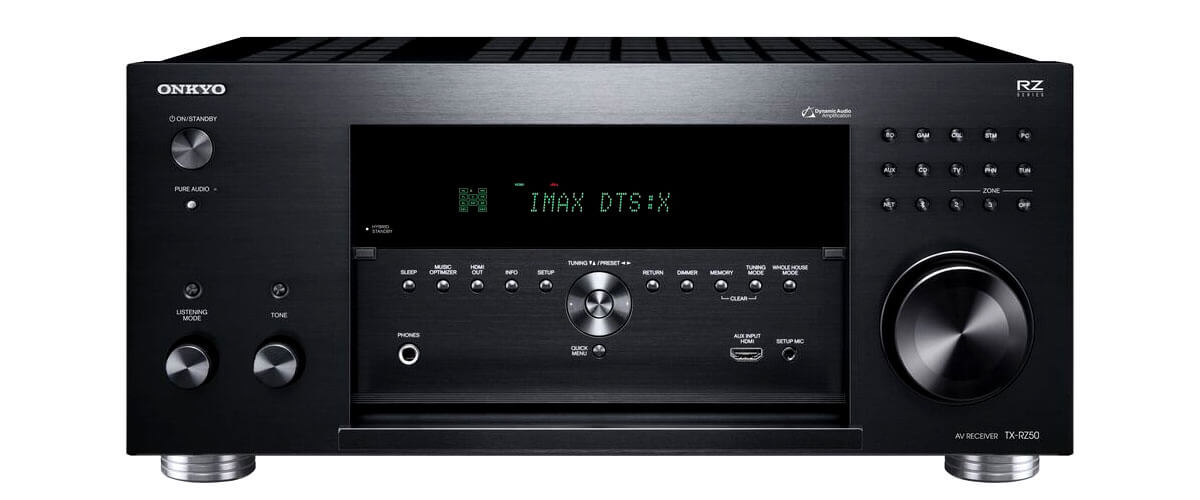
In the field of home theater receivers, Onkyo is a well-known company. One of their recent products, the Onkyo TX-RZ50, is proof of their dedication to providing high-quality audio and video performance. This receiver, introduced in 2021, is positioned as the top-of-the-line offering from Onkyo. The receiver provides a power output of 120 watts per channel for 8-ohm speakers, with a frequency response range of 20 Hz to 20 kHz and a total harmonic distortion of 0.08% while driving two channels. Like its predecessors, the Marantz Cinema 50 and Denon AVR-X4800H, the TX-RZ50 has 11 processing channels, but you can only connect 2 subwoofers.
The AV receivers market is not known for its stunning diversity, but Onkyo tries hard to refresh it. So, the TX-RZ50 has somewhat unusual looks. Yeah, it still features a large display in the middle and control buttons and surfaces on the sides, but it is all about button placement. You probably won’t find any other receiver with so many buttons on the front, and I can’t say this is a bad thing. But still this will be convenient for experienced users, but beginners may have problems adapting to this layout. The receiver is large and heavy, in the tradition of older models, giving a complete sense of reliability.
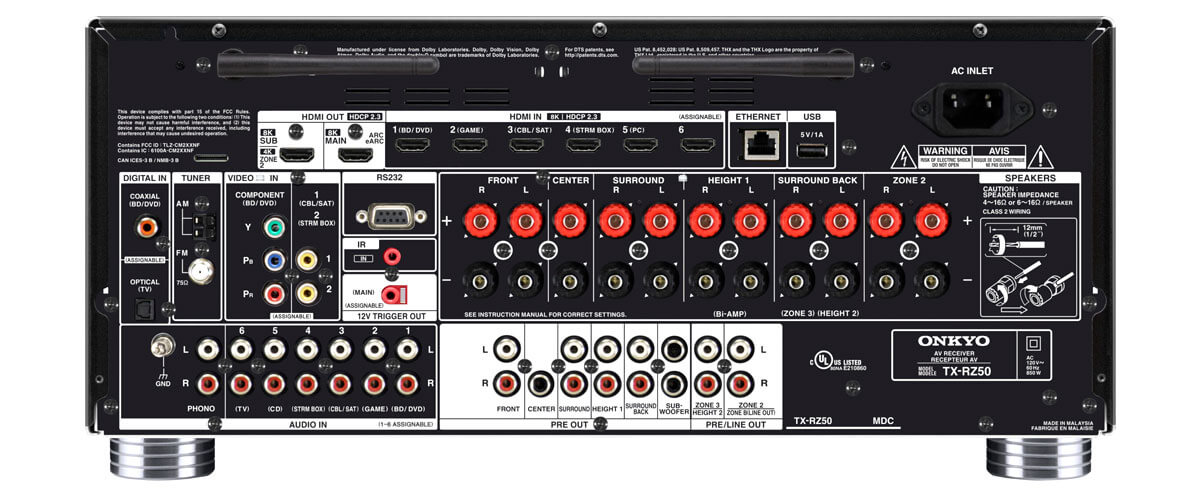
The rear panel of the Onkyo TX-RZ50 is well-organized and features a comprehensive array of connectivity options. The receiver has 6 HDMI inputs, 3 supporting 8K video, and 2 outputs. All are version 2.1 and work with 4K/120Hz, HDR10, HLG, Dolby Vision, and HDCP 2.3. With this set of features, you can enjoy all the content existing today. Considering its design, connectivity, and video features, for me, Onkyo TX-RZ50 has all the chances to be the best budget 9.2 receiver.
I must admit that the Onkyo TX-RZ50 sounds good in music but not amazing. Admittedly, the brand has taken a step forward compared to other Onkyo receivers (like its predecessor, the TX-RZ840), which can sound muddy or lack clarity. It has a clear, detailed sound without flashy accents like Denon or Marantz. It has the usual strong, clean sound. The unit provides decent balance, and if you’re not a sophisticated tracker, you’ll be completely satisfied with its sound.
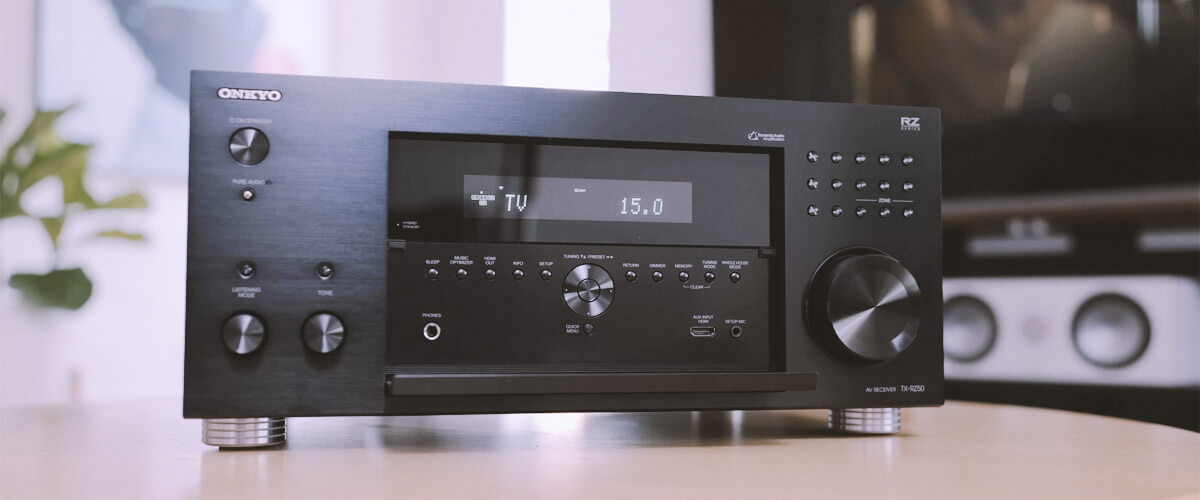
Regarding movie playback, the TX-RZ50 performed well during my tests, delivering fully immersive and dynamic surround sound. With support for 3D audio codecs such as Dolby Atmos and DTS:X, it created a stunning atmosphere through clear and powerful surround sound. Dialogue snippets were clear and intelligible. It also reproduced sound effects accurately and spectacularly. But if you compare it to Denon or Marantz, again, Onkyo’s overall soundstage is still inferior in brightness and variety.
The Onkyo TX-RZ50, a budget-friendly 9.2 receiver, is a versatile, high-performance home theater receiver that excels in both music and movie playback. Released in 2021, it competes with the Marantz Cinema 50 and Denon AVR-X4800H in terms of features and functionality (handling 11 channels and boasting extensive wireless capabilities), albeit with a flatter sound profile. While it may lack the bright accents of its competitors, its power and clarity are commendable, making it a solid choice for those on a budget.
However, it’s worth noting that it’s a noticeable step forward compared to previous generations of Onkyo. So, if you’re looking for an immersive movie-viewing experience or a powerful music system but don’t want it to put pressure on the family wallet, the TX-RZ50 will suit your needs quite well.
Key specs
- Channels: 9.2.
- Power output: 120W/8 Ohm.
- HDMI inputs/outputs: 7/2.
- Video functions: 8K/60Hz, 4K/60Hz, 4K/120Hz, HDMI upscaling up to 8K.
- Bluetooth/Wi-Fi: yes/yes.
- Streaming services: AirPlay 2, Spotify, TuneIn, Deezer, Tidal, Netflix, Amazon Prime.
- Supports: HDMI ARC, HDMI eARC, HDMI CEC, HDCP2.3, HDR10+, Dolby Vision.
- Surround sound: DTS HD Master, DTS:X, DTS Neural:X, Dolby Atmos, Dolby TrueHD, Dolby Height Virtualization, Dolby Surround, IMAX Enhanced.
Pros
- Like more expensive models, the Marantz Cinema 50 and Denon AVR-X4800H, Onkyo TX-RZ50 process 11 channels with an external amplifier.
- It is not inferior to the rating leaders in power and functionality.
- The comprehensive array of connectivity options.
- Easy-to-read LCD.
Cons
- Beginners may find the number of buttons on the front of the receiver overwhelming and cluttered.
- The overall soundstage is simpler than the Marantz Cinema 50 and Denon AVR-X4800H, without flashy accents, and loses out against them (though generally powerful and clean).
Yamaha RX-A6A
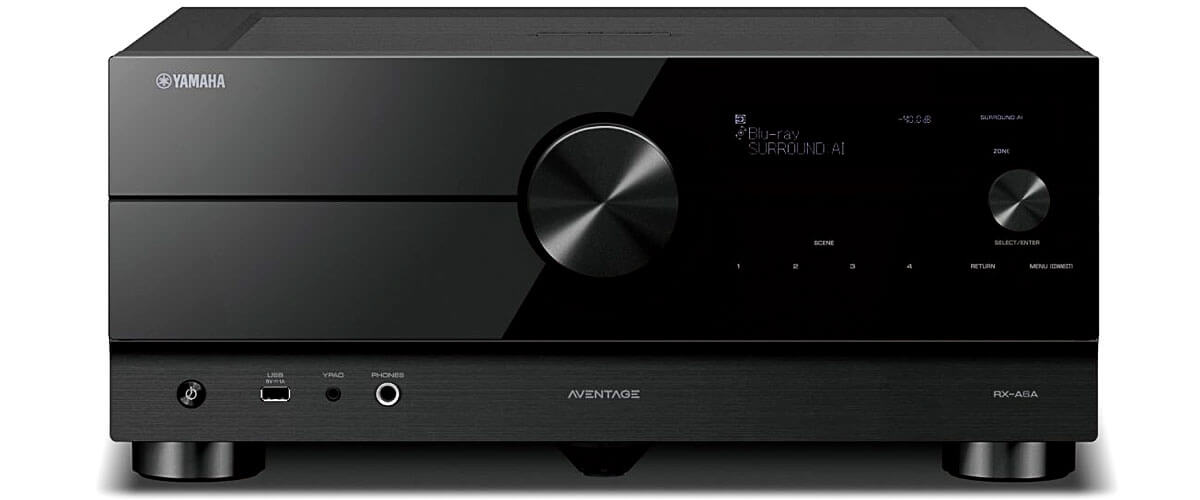
Yamaha has been a leading manufacturer of home theater receivers for decades, and RX-A6A continues its legacy of producing high-quality audio and video equipment. Released in 2021, it is positioned as one of Yamaha’s flagship models, offering cutting-edge features and technology.
Despite its impressive capabilities, the receiver is surprisingly compact, measuring 17-1/8 x 7-1/2 x 18-5/8 inches (W x H x D) and weighing 41.2 lbs. On the other hand, it is the heaviest receiver in the review. Despite this, Yamaha’s RX-A6A looks subtle and sophisticated, emphasizing utility over showy aesthetics. The receiver comes in a black finish. This unit is still a well-made, professional-looking item that will fit in with the majority of home entertainment systems.
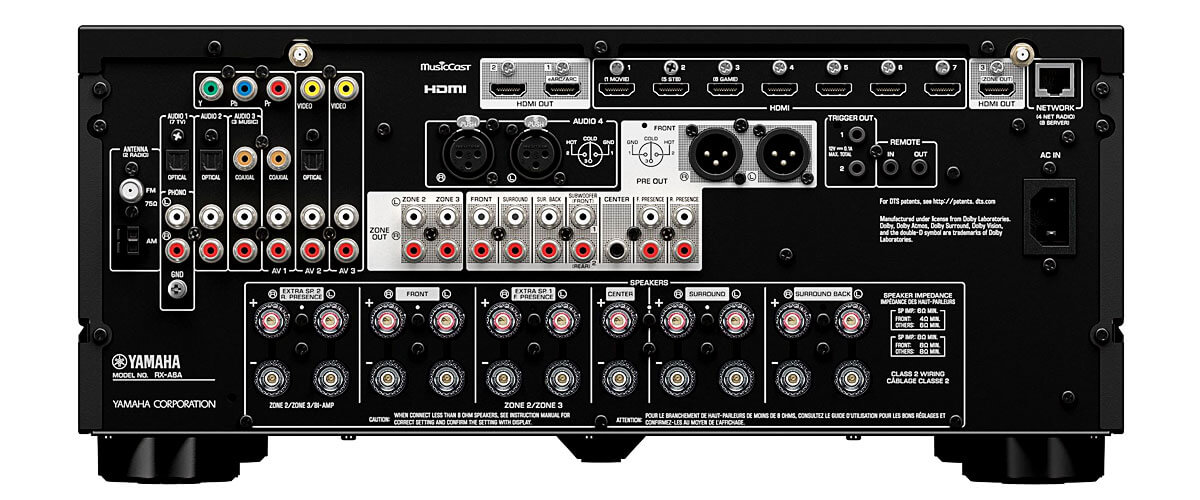
The Yamaha RX-A6A boasts a powerful amplifier capable of delivering 150 watts with a low distortion of 0.06% at 8 ohms. Altogether, it is more than enough for medium or even large rooms to get immersive and quality sound. In terms of digital connectivity, the receiver offers rich amounts of coaxial and analog inputs, 7 HDMI inputs with support for HDMI 2.1 and HDCP 2.3. The Yamaha RX-A6A also features a front USB port.
After testing the unit, I can confidently say it delivers a truly immersive movie-watching experience. Compared to the Onkyo TX-RZ50, this unit outshines it in terms of surround sound and audio clarity. Also, Yamaha RX-A6A supports MusicCast Surround technology allowing me to use wireless rear speakers, which helped me a lot as it became far more convenient to make changes to my studio to test different layouts.
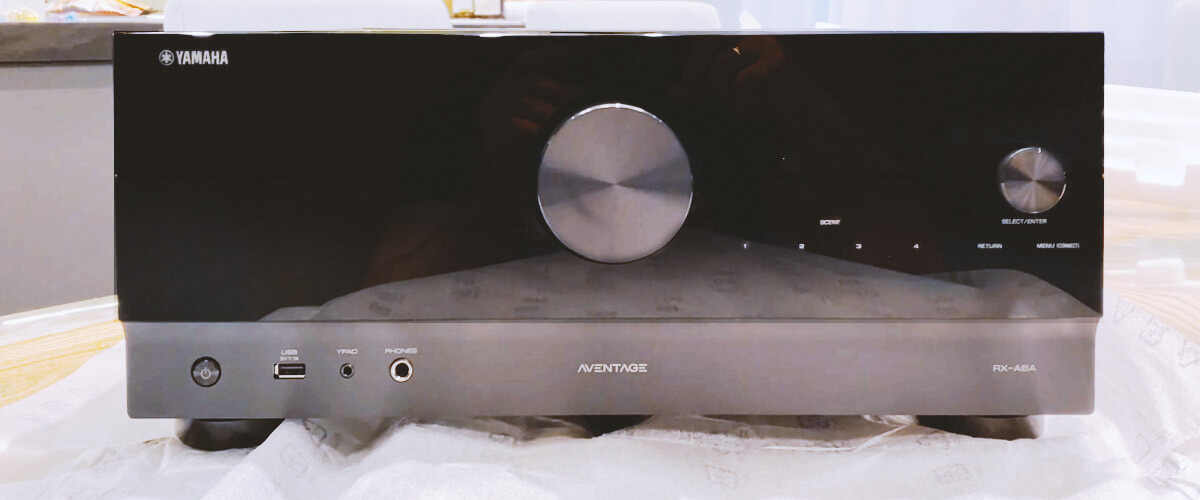
When it comes to music, the Yamaha RX-A6A delivered a clear and balanced sound with excellent separation and imaging. Surprisingly, it didn’t lack the power, even when I maxed out the volume during hard-rock tracks. But, at the same time, it didn’t manage to deliver juicy lows and clear highs as the Cinema 50 did.
Overall, the Yamaha RX-A6A provides a comprehensive set of features for movie lovers, demanding audiophiles, or video game fans. It is definitely a good option and a worthy competitor to all models in my chart.
Key specs
- Channels: 9.2.
- Power output: 150W/8 Ohm.
- HDMI inputs/outputs: 7/3.
- Video functions: 8K/60Hz, 4K/60Hz, 4K/120Hz, HDMI upscaling up to 8K.
- Bluetooth/Wi-Fi: yes/yes.
- Streaming services: AirPlay 2, Spotify, TuneIn, Deezer, Tidal, Netflix, Amazon Prime.
- Supports: HDMI ARC, HDMI eARC, HDMI CEC, HDCP2.3, HDR10+, Dolby Vision.
- Surround sound: DTS HD Master, DTS:X, Dolby Atmos, Dolby TrueHD, Dolby Height Virtualization, Dolby Surround, Auro 3D.
Pros
- Has a powerful amplifier capable of delivering 150 watts.
- Delivers a clear and balanced sound with exceptional separation and imaging.
Cons
- May not be as cinematic as some other high-end receivers, like the Denon AVR-X4800H.
- During music playing, it wasn’t able to provide the same sweet lows and crisp highs as the Marantz Cinema 50.
Pioneer Elite VSX-LX505
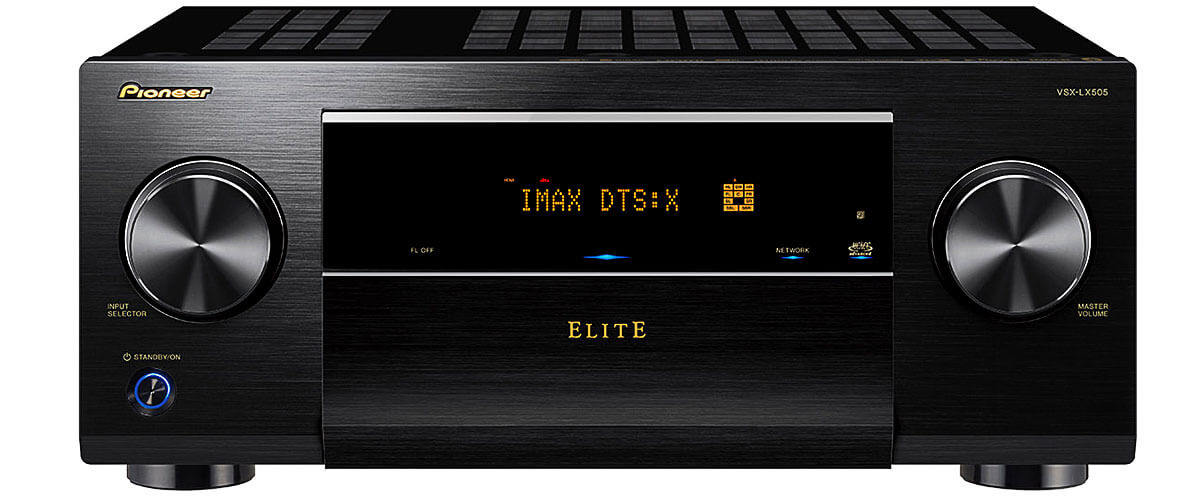
The Elite VSX-LX505 is a high-end AV receiver released in 2018 by the well-known electronics manufacturer Pioneer. The model is positioned as a flagship receiver. The VSX-LX505 measures 17-1/8 x 7-5/16 x 15-3/16 inches and weighs 28.7 lbs, making it a compact and lightweight option compared to other models in its class.
The Pioneer Elite VSX-LX505 is a stylish, contemporary-looking surround sound receiver. It comes with the support of Dolby Atmos, DTS:X, DTS Virtual, and Neural:X. The unit delivers a power output of 120 watts at 8 ohms, covering a frequency range of 20 Hz to 20 kHz with a total harmonic distortion of 0.08% when two channels are driven.
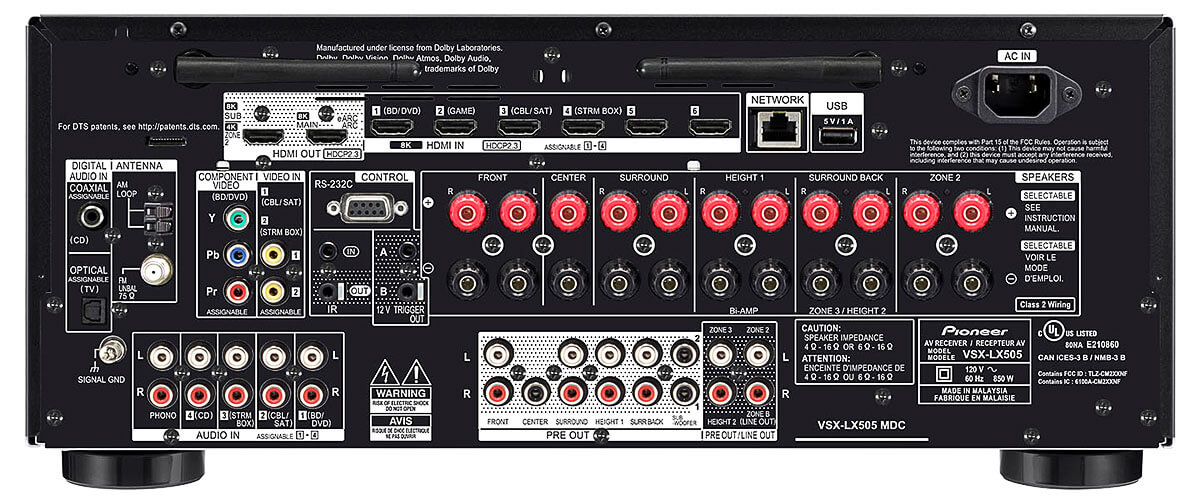
The back panel of the Pioneer Elite VSX-LX505 includes 6 2.0b version HDMI inputs, 4 of which are assignable, and 2 HDMI outputs. All of them come with HDCP 2.2 copy protection. These connectors allowed me to use multiple sources with the receiver, including a gaming console, a Blu-ray player, and a cable box, and switch between them with ease. The back panel of the VSX-LX505 also has Ethernet and USB ports. I liked that the front panel of the VSX-LX505 includes a single HDMI input and a USB port for connecting a USB drive.
When I tested the Pioneer Elite VSX-LX505 in my favorite movies, including those from the list, but also Marvel Avengers and Back to the Future. It provided an exciting experience. It’s also worth noting that the Dirac Live Room Correction system worked very well and adjusted the sound in my room in no time. Among the most prominent aspects I definitely can notice are powerful bass, distinctive dialogues, and explicit sound effects.
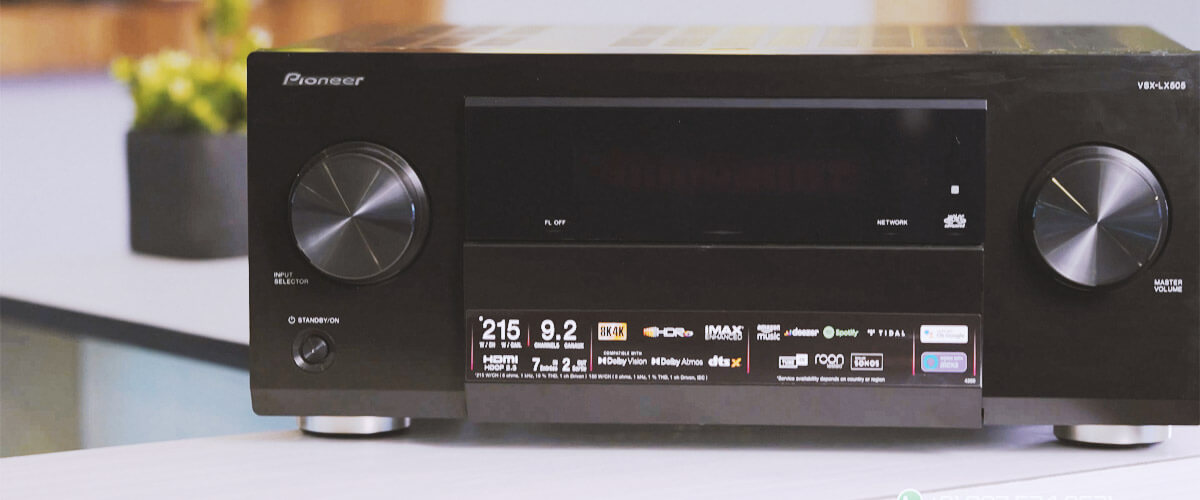
Talking about music, the Pioneer Elite VSX-LX505 delivers a smooth and detailed sound regardless of the genre. I also noticed a very pleasant instrument separation. Those are not as distinctive as in the case of stereo receivers. However, you won’t be disappointed with how the VSX-LX505 handles sound in music.
Overall, while the Pioneer Elite VSX-LX505 is not the best 9.2 receiver, it is still a solid choice. It gives you exactly what you expect – a powerful and immersive sound suitable even for the largest rooms while avoiding distortions and noises in music and movies. At the same time, it does it without the “WOW” effect.
Key specs
- Channels: 9.2.
- Power output: 120W/8 Ohm.
- HDMI inputs/outputs: 7/2.
- Video functions: 8K/60Hz, 4K/60Hz, 4K/120Hz, HDMI upscaling up to 8K.
- Bluetooth/Wi-Fi: yes/yes.
- Streaming services: AirPlay 2, Spotify, TuneIn, Deezer, Tidal, Netflix, Amazon Prime.
- Supports: HDMI ARC, HDMI eARC, HDMI CEC, HDCP2.3, HDR10+, Dolby Vision.
- Surround sound: DTS HD Master, DTS:X, DTS Neural:X, Dolby Atmos, Dolby TrueHD, Dolby Height Virtualization, Dolby Surround, IMAX Enhanced.
Pros
- Dirac Live Room Correction system does its job very well and truly helps to set up and tune the whole system.
- Delivers a smooth and detailed sound regardless of the music genre.
Cons
- It takes longer for this unit to react when switching inputs or adjusting volume.

